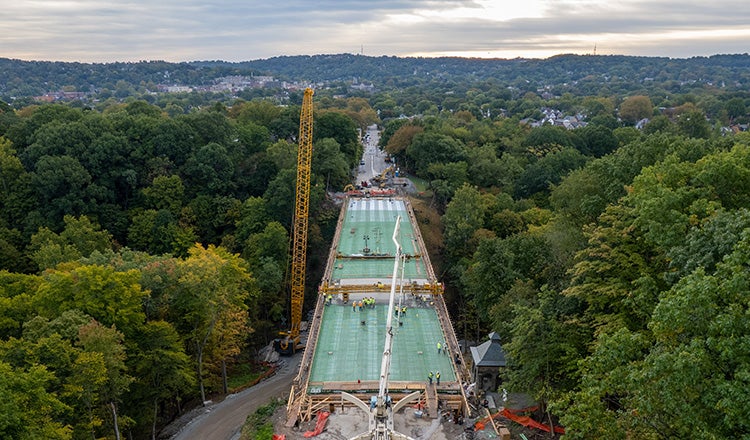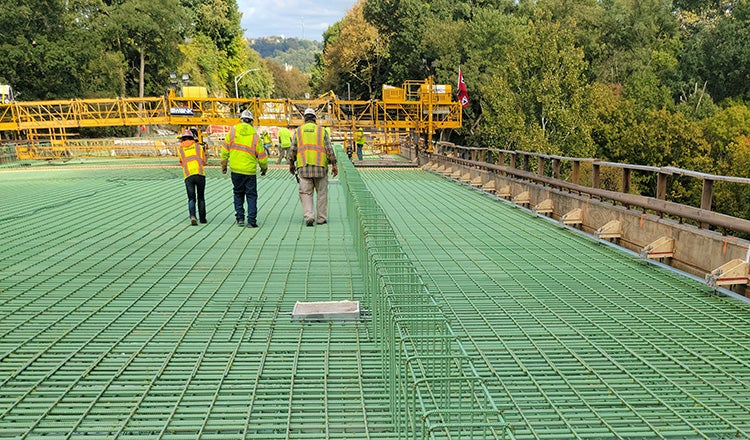Fern Hollow Emergency Bridge Replacement

Fern Hollow Emergency Bridge Replacement
A Fast-Tracked Process to Design and Construct a New Bridge in Less Than a Year
Before daylight on Friday, Jan. 28, 2022, a bridge in the east end of Pittsburgh suddenly fell more than 100 feet into a park ravine. Just over 10 months later, a new 460-foot, four-lane bridge opened to traffic, accomplished through a fast-tracked design and construction process.
The Pennsylvania Department of Transportation chose the design-build team of HDR and Swank Construction to replace the structure within days of the collapse, using emergency procurement procedures. HDR provided a wide variety of services on the $25 million project in the following months, including preliminary design, hydraulic engineering, geotechnical engineering, public involvement, permitting services, visualisation, utility relocation, final design of the bridge, and continued coordination through construction.
Expedited Work and Strong Collaboration
Our team worked with PennDOT, the City of Pittsburgh and Swank to define the replacement structure based on material availability, available resources, and the vision for the replacement structure. A critical factor was determining a replacement structure that could be built quickly. We defined the scope and schedule of the project, modifying the normal process to facilitate a compressed delivery. Within weeks, our team produced a preliminary concept for a three-span bridge made of prestressed concrete, with four vehicle lanes, a 5-foot sidewalk and a 10-foot-5-inch shared use path (a 50% increase for bicycles and pedestrians).
With the concept accepted, design quickly followed. And in April, less than three months after the collapse, the first shaft was drilled. The first beam was delivered in July, and the concrete deck was poured in September and October. Traffic began flowing again in late December, with the entire project scheduled to be complete in mid-2023.

The extensive collaboration of the project team enabled critical decisions to be made much more quickly than typical projects. A typical project of this size would take about five years to plan, design and construct. With estimated final completion to be about 17 months after the collapse, the Fern Hollow replacement will be finished in less than a third of the usual time.
Overcoming Design Challenges
The fast-paced schedule was made possible in part by the experience and expertise of its team, who at times were required to make educated design decisions without all of the usual engineering information. Those decisions were then confirmed as the project progressed and the engineering was completed.
Other challenges included a site that did not always have clear property boundaries or ownership due to the park below the bridge, environmental permitting that was heavily dependent on the construction means and methods, supply chain and demand issues that affected materials and equipment, and a project scope that frequently changed.
Community and agency collaboration was a priority, requiring coordination between community groups and city and state agencies. The bridge also includes some of the heaviest and longest prestressed beams used on a project in Western Pennsylvania. The finished bridge includes 21 PA Bulb-Tee Beams, each 152 feet long, 4 feet wide and 8 feet deep and weighing more than 200,000 pounds.

HDR quickly mobilized its experts to tackle the project, eventually pulling in five dozen employees from offices across Pennsylvania. Their work extended beyond typical bridge design and engineering. For example, our wastewater practice designed a replacement for a sanitary line that was damaged in the collapse. And our permitting experts in Pittsburgh worked as an extension of PennDOT’s permitting department to develop a strategy that would satisfy the project’s environmental requirements while maintaining its aggressive schedule.
A Community Reconnected
The project restores emergency service routes and transit routes (eliminating a time-consuming detour through surrounding neighborhoods) and pedestrian connectivity to the community and enhances bicycle mobility for park users and commuters. It is also an emergency snow route for the city, important in Pittsburgh’s chilly winters. The new bridge is accessible to more vehicles, without the posted weight restriction on the previous structure. And we made it more than just functional by adding aesthetic treatments to the bridge and working with the Pittsburgh Art Commission and the community to select artists to design art for the bridge.
Throughout the design and construction of the replacement Fern Hollow bridge, public interest was high, with frequent progress reports in local, national and international media. From the beginning of the accelerated, complex, high profile effort, the entire project team focused on delivering high quality work that would quickly restore this important neighborhood connection.












